South Devon Railway
Summer House
In which Joe does not visit the most obscure engine house on any atmospheric railway, but does come to some new conclusions about the South Devon Railway piston carriages and maybe others.
Explorations: 25 June and 11 October 2018, and 28 June and 21 October 2019.
Journey: Paddington to Exeter St Davids, and St Davids to Newton Abbot.
-
OFTEN CITED REFERENCES
- Paul Garnsworthy, editor, Brunel's Atmospheric Railway, The Broad Gauge Society, 2013.
- Peter Kay, Exeter–Newton Abbot: a Railway History, Platform 5, 1991, and excerpts in Garnsworthy.
- Howard Clayton, The Atmospheric Railways, the author, 1966.
- Charles Hadfield, Atmospheric Railways, David and Charles, 1967.
- G.A. Sekon, A History of the Great Western Railway, Digby, Long, 1895.
The seventh engine house on the South Devon Railway was Summer House. It was at an isolated spot along the River Teign, and like Countess Wear and Turf, it was named for the nearest landmark, which was in this case a small cottage built by the Reverend John Comyns (1775-1856) on a rock almost off shore. From 1813 he was the vicar of Bishopsteignton, where he lived his whole life. His mother Joan Pidsley was from the family that owned Wear Farm, where the engine house was built.
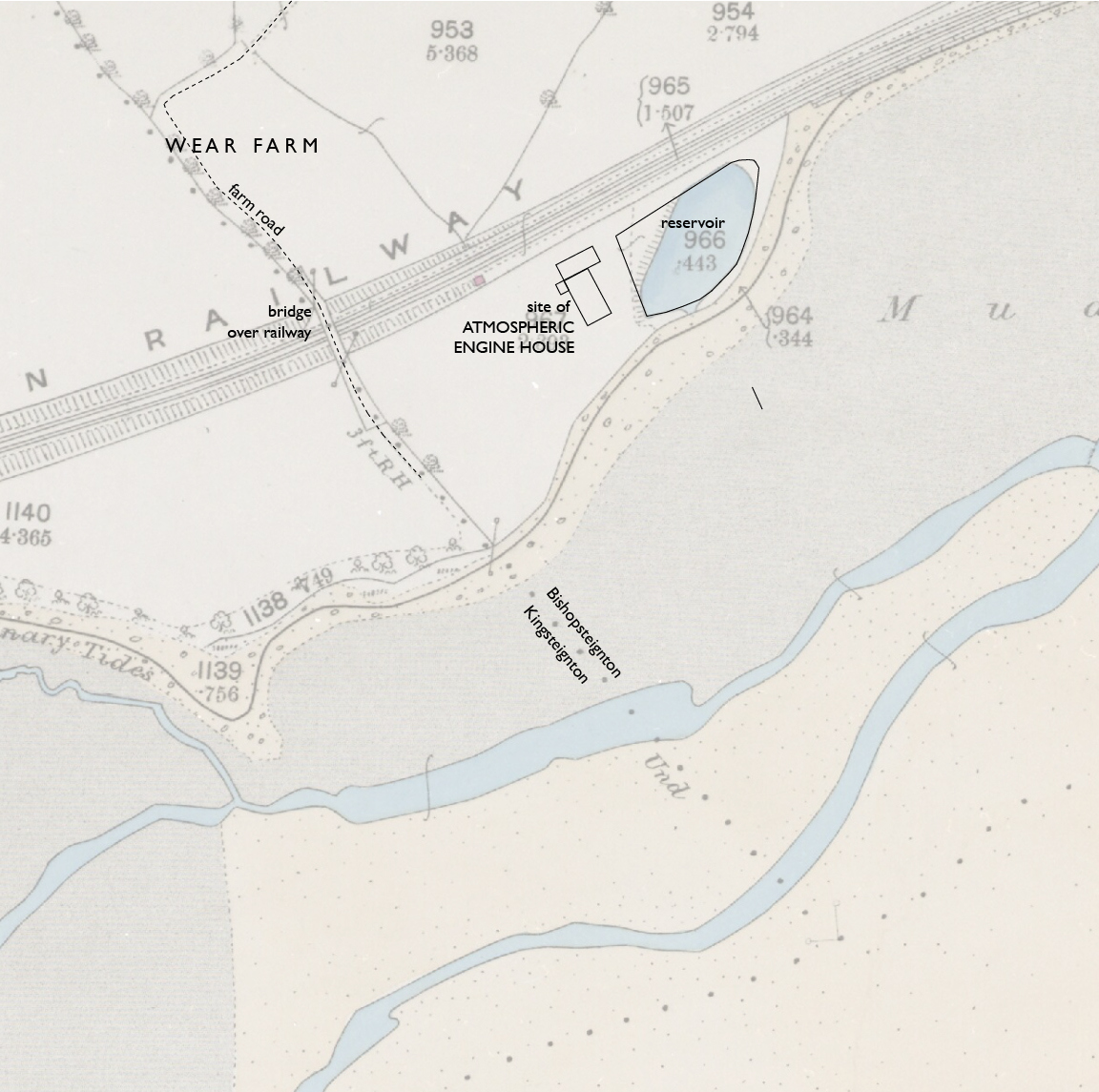
— Site of Summer House, Ordnance Survey 25-inch, 1890. CC BY-NC-SA 4.0 courtesy National Library of Scotland.
Annotations by Joseph Brennan.
Nothing was evident by 1890 aside from what was left of the reservoir. The buildings were demolished in 1855, two years after the engines were sold. A very small building is shown next to the railway, purpose unknown at such a remote spot. The border between the Teigntons (dotted line) is noted as being "3 feet from Root of Hedge" and then out in the mud it is "undefined".
We know the location of the atmospheric buildings thanks to William Dawson's plan, shown below, where they are seen toward the left side. Like the Teignmouth plan I show this one upside down, to put north at the top.

— William Dawson, plan at Summer House, via Brunel's Atmospheric Railway.
The bridge over the railway and the field boundaries are the same here as they were forty years later on the OS map. The degree to which the railway was built out into the mud, shown as water, is very apparent. The summer house is the little pink circle on a rock at right center. Near the right edge of the plan is a high footbridge where the railway cut through the aptly named Red Rock. Dawson does not show Luxton's Steps leading down from there to the river, where there was a ferry across to Coombe Cellars. A public footpath leads to the bridge today, along the last field line on the right.
Below, Dawson provides also a good view of the summer house itself, with the atmospheric buildings off in the distance (under the four gulls). In Brunel's Atmospheric Railway we read that the cottage was octagonal and built of limestone. Neither here nor in the plan do we see any way to get to the cottage except by crossing the track. I think it was abandoned by the time the reverend passed away.

— William Dawson, view from Summer House, via Brunel's Atmospheric Railway.
Summer House today
Below is an aerial view of the site today. There is still a bridge for Wear Farm, and the field lines are similar. I have located the buildings and reservoir based on the information available. Maps over the years show that the bank between the reservoir and Teign estuary was broken many decades ago, but well into the twentieth century it still contained water from the river. The field has covered over the building site. The reservoir site has been left to trees and shrubs and is gradually eroding away. I don't know of any investigation of this site.
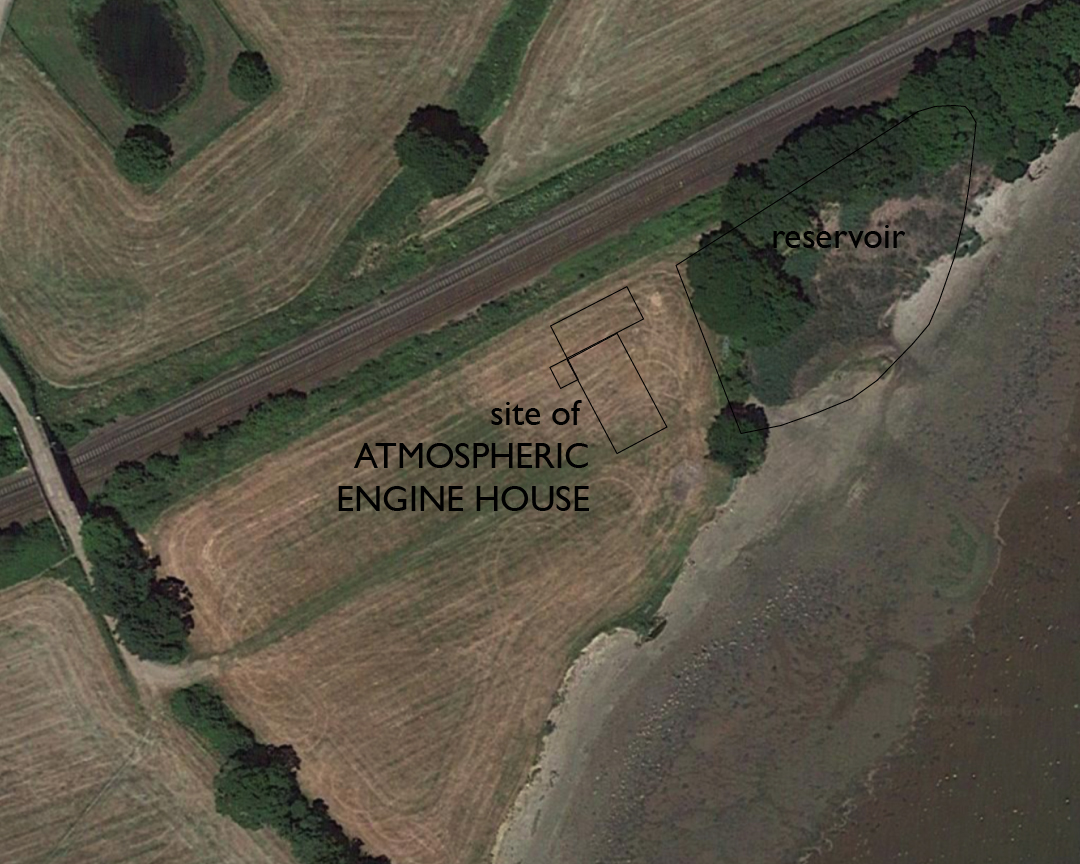
Google : imagery © CNES / Airbus, Getmapping.plc, Infoterra Ltd & Bluesky, Maxar Technologies, 2020. Annotations by Joseph Brennan.
Access is uncertain. Wear Farm includes a caravan site ("trailer park" in American), but several years ago it was closed to camping and caravans. It is now a "residential park home estate" for caravans that do not move around. Recent listings call it Orchard View Wear Farm. From time to time one of the caravan houses is offered for sale, but the land is subject to a monthly ground rent. Also within the property is a Grade II listed building, "Wear Farmhouse and Kitchen Garden Walls" of which English Heritage notes: "Probably early C17 with late C17/early C18 remodelling, although the origins of the house may be earlier."
An hourly bus service between Teignmouth and Newton Abbot has a stop at the entrance to Wear Farm. It's clear on maps that the road past the caravans continues between fields and over the bridge to more fields along the river. But I think it is a private farm road, so inquiry should be made before visiting. I was not able to identify who should be asked, but an estate agent handling a sale should be able to provide information.
The other way to see the Summer House site is by train— if you don't blink. The trains run fast here. I think it's easier to catch the landmarks going from Newton Abbot, but here is both ways:
From Teignmouth: Ride on the left-hand side. Note the long bridge to Shaldon, and then go under 1-small driveway bridge, 2-road bridge, and 3-high footbridge (Luxton's Steps). Then close together, two places where a little bit of land juts out, the second of which was the site of the summer house. In the wide turn to the left, as soon as you see trees on the left, that's the reservoir site, followed by open ground where the buildings were, and then the Wear Farm bridge.
From Newton Abbot: Ride on the right-hand side. Pass the Hackney Engineers' sidings and a bridge over water. Go under 1-wide highway bridge and 2-road bridge to Passage House, and 3-Wear Farm bridge. The buildings were in the open ground, and the reservoir site is where the trees are. The next place where land juts out is the site of the summer house.
Below is a driver's eye view running from Newton Abbot. The buildings were in the field, and the reservoir was up ahead where the trees are.
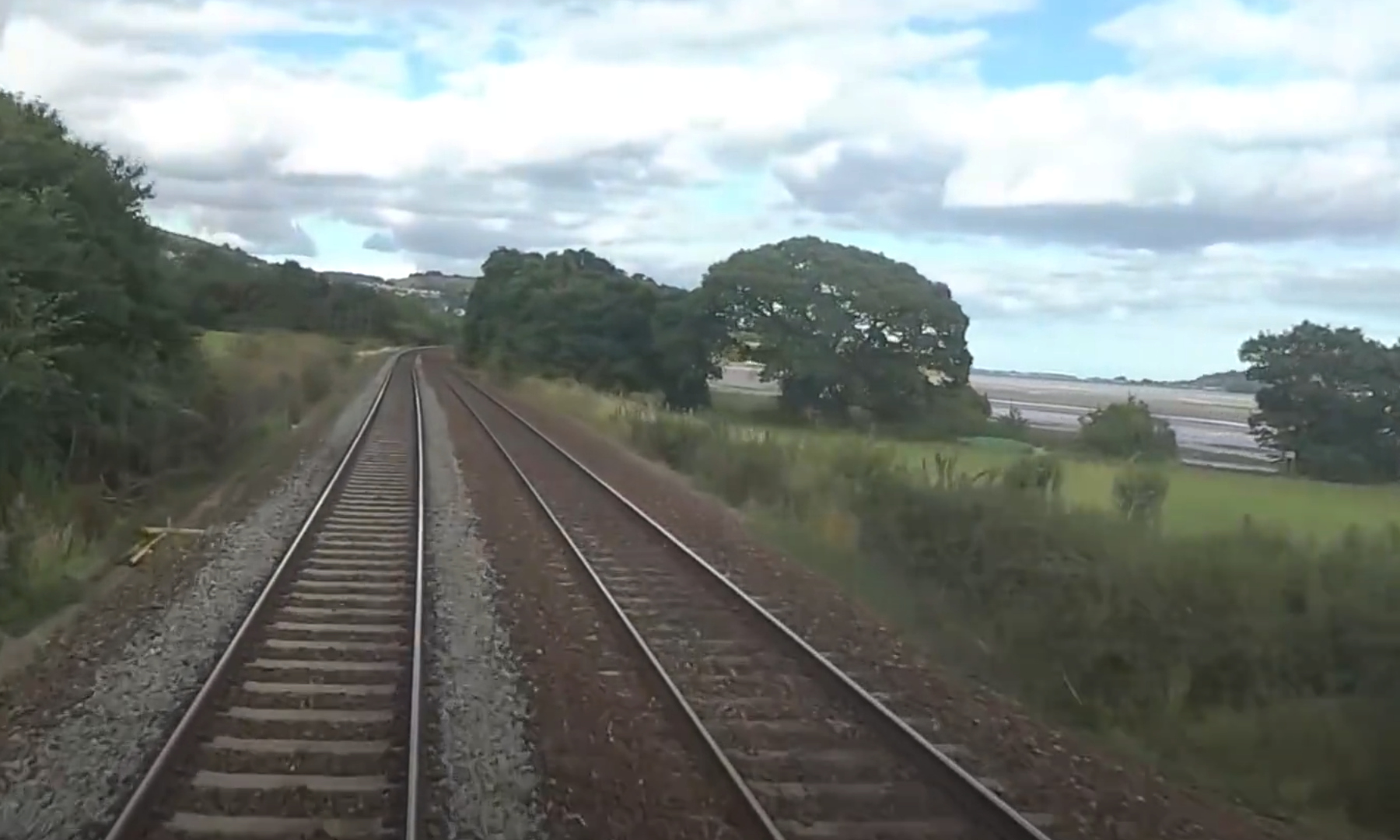
— "A Drivers Eye View from Paignton to Exeter St Davids...", screen cap at 17:36, from Railmart Ltd on Youtube. Probably 2019 or 2020.
The South Devon Railway Piston Carriage
We had good images of the London and Croydon piston carriages and those on the Saint-Germain railway. I almost didn't notice that there is no image of the Dalkey piston carriage, which was always at the upper end of the only train, and therefore not visible in the picture at Kingstown.
The South Devon Railway had at least four piston carriages, the minimum needed to work the full Exeter–Newton service in 1848, and very likely a few more than that. But what did they look like? In Brunel's Atmospheric Railway the team of Paul Garnsworthy, Eddy Brown, and Geof Sheppard tell a groundbreaking tale.
But first, let's review the usual story. The diagram below details the Samuda brothers' venture in detail. I don't know the ultimate source for it, but I think it is very early. The passenger car has the wording "Clegg and Samuda" on one door and "Atmospheric Railway" on the other. The drawing at upper right includes "Seat for Guard", which to my mind blows away the idea that the side view of the piston carriage simply omits a body in order to focus our attention on the piston mechanism. May I suggest that we are looking at the rolling stock of the demonstration railway in London in 1840, when Clegg was still with the venture. The picture assures us that the train had respectable passenger accommodation, and if the piston carriage was no more than a flatcar with a seat, it proved that they were not hiding a small engine somewhere.
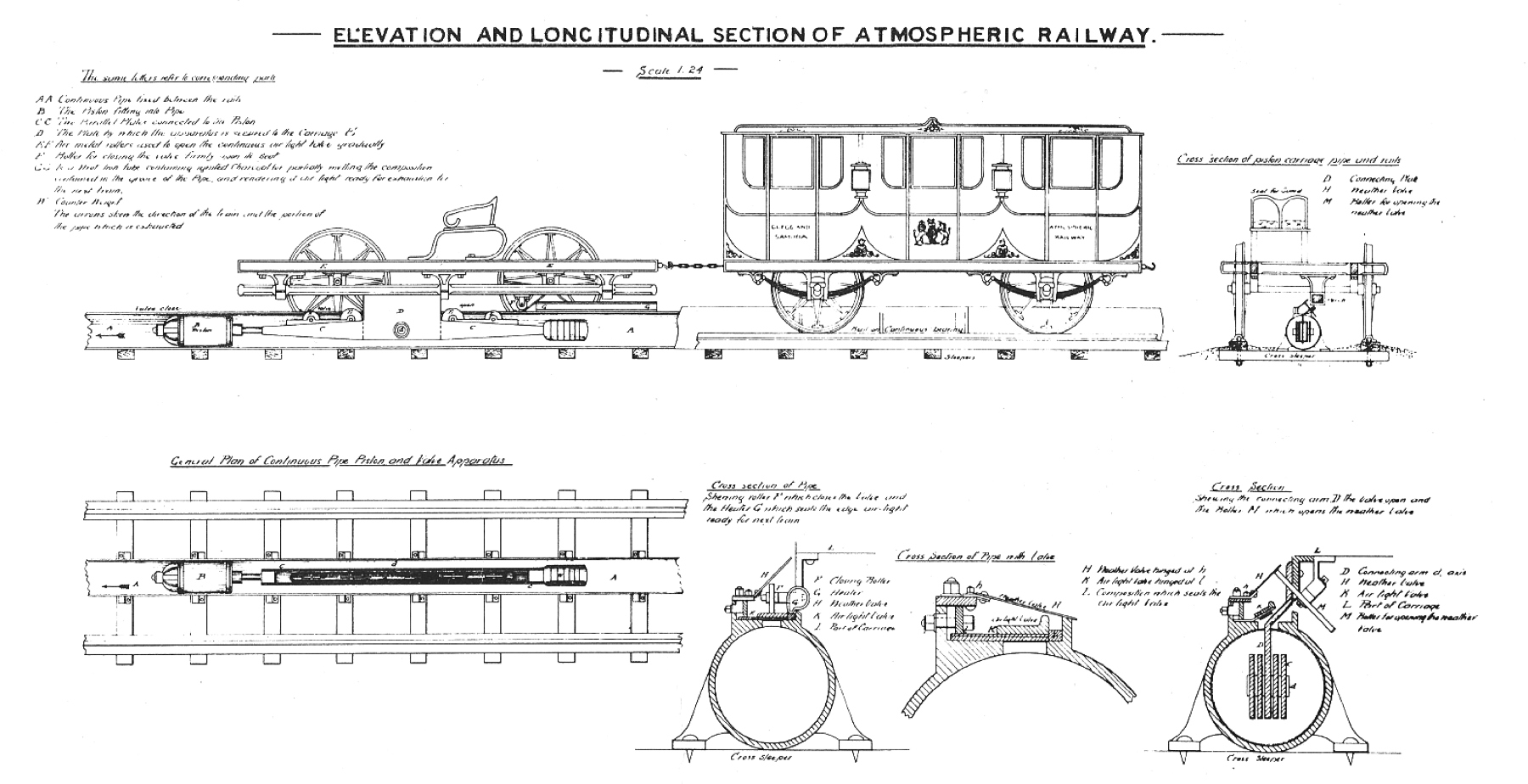
— unknown, via Clayton, The Atmospheric Railways.
You can find all over the web redrawn cleaned-up versions like the one below, which are represented as a typical atmospheric railway train.

The culprit seems to be the picture below, by Robert Barnard Way, a commercial artist and writer active from 1930 to 1958. His artwork ranged from technical drawings of machinery to children's books, and he depicted an especially large number of railway subjects. His atmospheric railway scene is obviously based on Nicholas Condy's painting of Dawlish, with the addition of a northbound train. He has added to the Samuda flatcar a flimsy pipe railing in front and what might be some type of control at the driver's right hand. I don't know what the lumps are on top of the train.
I'm sure he did not anticipate the damage that one inspiring image can do when impressionable boys and girls take it to be historically accurate. There are many copies of this image not only on the web but in places that should be more careful. Sad to say, what you see here is my photograph of an exhibit at the STEAM museum in Swindon, an otherwise good museum of the Great Western Railway.
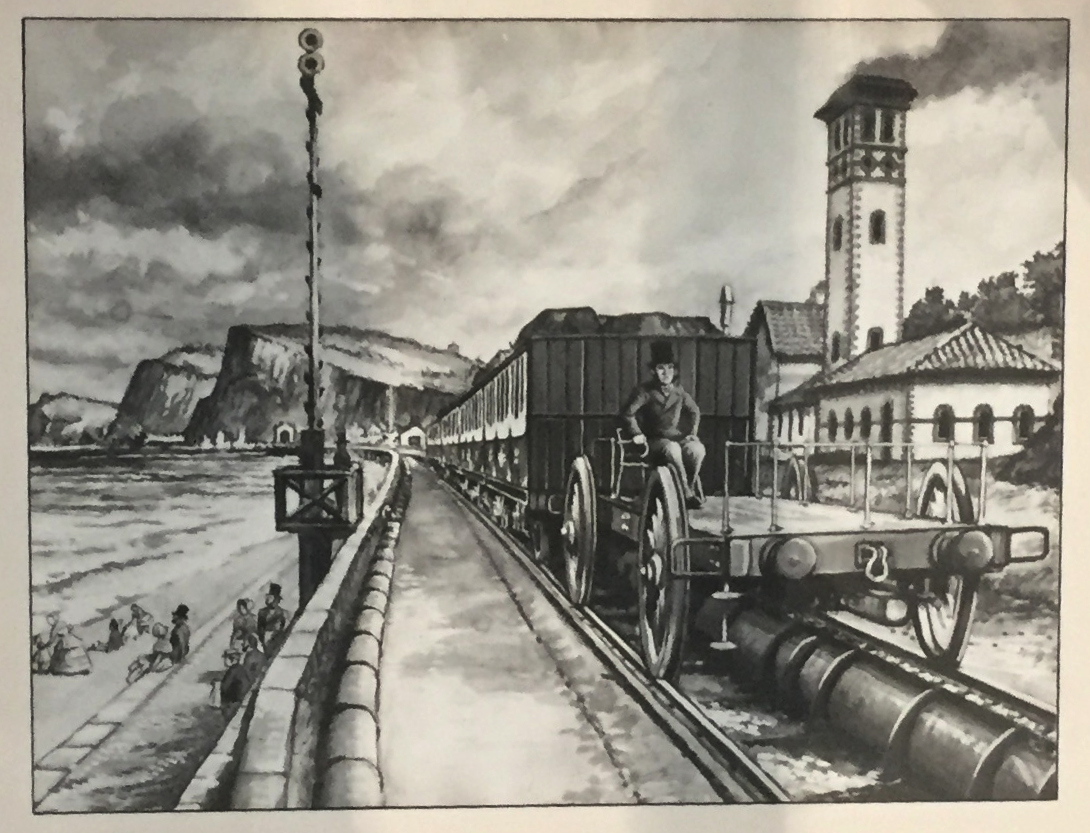
— Robert Barnard Way, imaginary picture of an an atmospheric train.
The damage continues at the Being Brunel museum within the SS Great Britain museum in Bristol. It opened in 2018, five years after publication of the research in Brunel's Atmospheric Railway. The large painting follows closely Way's vision, right down to the lumps on top of the train. The red building reminds me of Starcross but the scenery does not. There a nice trompe l'oeil effect at the bottom, where the picture blends into the real 22-inch pipe that was once at the Starcross museum. The wheels with flanges on both sides should be grounds for suspending an artistic license.
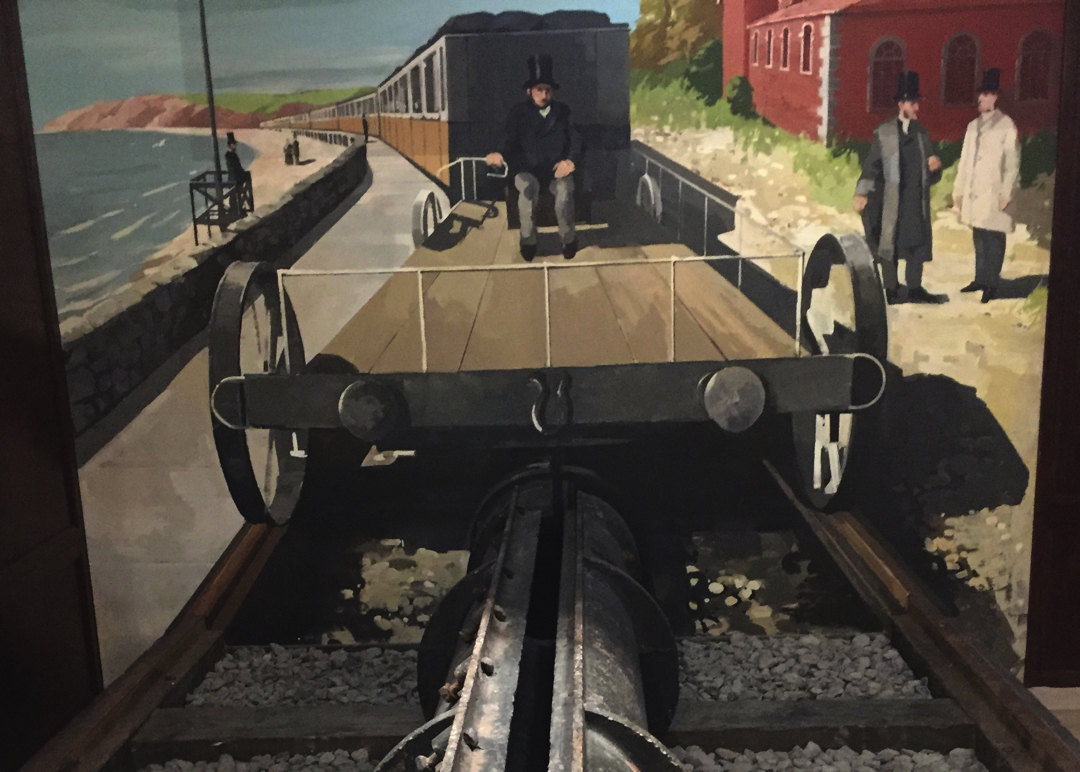
It was not necessary to guess what the South Devon piston carriage looked like. William Dawson painted one of them.

That looks a lot more like the Croydon and Saint-Germain piston carriages. Even without knowledge of the Dawson painting, a box shape like this could have been predicted. The policeman giving the "all right" signal with his arm proves that this is the front of the train.
The Croydon and Saint-Germain piston carriages had six wheels with the piston coulter between the middle pair. Not only is it likely that the South Devon used a six-wheel design too, but there is hard evidence!
In 1993 the Brunel's Atmospheric Railway team had a chance to look through a large set of Great Western Railway documents called the Woodfin Collection, then at the City of Bristol Museum and now at the STEAM Museum in Swindon. There "we stumbled across a real bombshell," they write, namely photographic negatives of "drawings of one of the elusive South Devon Railway piston carriages." The drawings were dated 23 November 1846, which is three months before the first piston carriage arrived.
The book has four pages of precise CAD drawings by Paul Garnsworthy based on the find. They show a six-wheeled piston carriage similar in general appearance to the four-wheeled passenger carriage in Samuda's drawing. Each side has four doors to three compartments, the larger middle one being second class with two doors, and the others third class. The conductor's platform at each end has three windows across, two glazed, and one open to clear the brake handle. As usual the handedness of the longitudinal valve, hinged on the sea side of this railway, ruled out simply rotating the car at each terminal. The drawings are the usual half-views used on symmetrical bodies, so Garnsworthy had to assume that the carriages were double-ended, which I agree with. Since the brakes were on the land side, the open window was on the right moving toward Plymouth and on the left toward Exeter. Garnsworthy assumes also that there were two pistons, to avoid the tedious detaching and carrying that was done on the Croydon railway at each terminus. For much more detail see the book.
William Dawson's painting shows a piston carriage of a very different appearance. Garnsworthy suggests that it is nearly the same but with the wood frame lined only on the inside. That seems odd. Were the carriages delivered in this state, or were some built differently than others? There is just no way to answer these questions.
A review of the Croydon illustrations suggests that the piston carriages' three side windows might be for passenger compartments, the oldest picture suggesting doors at two places. This in turn suggests that they may have run through to London, because otherwise the train would have been one car shorter where the demand was greatest. And then that might explain a fleet of six piston carriages on a railway that could not run even two trains at once, for want of passing loops. And then, if the piston carriage was not shunted at Forest Hill, it would explain the quick power change. It would even imply that the piston carriage could run over normal points or crossings, and come to think of it, the track arrangement at Croydon implies that too, since access to the sidings ran across the path of the atmospheric train. There is no evidence in contemporary accounts of the Croydon line for any of this, except that it explains so many things. The Saint-Germain piston carriage ran through to Paris as a baggage car, but not until 1848.
NOTES
The dates I give at the top are when I passed Summer House and looked out the window trying to figure out where it was. I think I nailed it on the eighth pass, but I couldn't get a picture fast enough.
TODAY'S ETYMOLOGY
The names Bishopsteignton and Kingsteignton obviously derive from their location along the Teign. The last part "ton" is almost certainly the Saxon tun, "fenced area", indicating a farm. The origins of Teignton are reasonably said to be Saxon, but beyond that I find conflicting stories, most of them without sources. Teign Farm is a pretty obvious name for the location. Kingsteignton is bordered both south and west by the Teign, which takes a sharp turn where it debouches into the estuary.
The partition between bishop and king dates to the grant of of King William in 1069 to the See of Exeter under Bishop Leofric. The bishop's part appears as TANTONE in the Domesday Book, Devon folio 4. The king's lands of course come first, in Devon folio 1, under the heading TERRA REGIS. There we find among others the record that starts REX ten[et] TEINTONE T.R.E.. All the king's records begin with "the king has", with a little squiggle after the n to save writing et. The initials T.R.E. follow when the land was previously a Terra Regis of King Eadweard.
It's hard for me to read, so I'll add just the next words, which are geld una hide 7 una virgade (the 7 being the usual manuscript ampersand). This refers to the land tax begun by King Æthelred and continued by the Normans, which was assessed by "hide" (about 120 acres) and "virgate" (¼ of a hide). Only a small part was the king's demesne (farmed for the king himself), the rest being farmed by villeins and their boarders and serfs. The manor had a total of 16 hides, which I make to be about 1,920 acres or 3 square miles, roughly the size of Kingsteignton today. There were 13 teams of oxen to plough the land, usually 8 oxen per team, and 30 sheep. Clearly the main activity was growing crops in the fields.
Note the spelling Teintone. I wonder whether this was the king's Norman accent vs Leofric's Saxon. I find this reasoning on the village website:
The name, Bishopsteignton, may seem strange, especially since the middle syllable is pronounced "tain" rather than "teen", as the River Teign is pronounced. The name in fact is not derived from the river itself, but instead from the Celtic word for river, which is Tain (or teign), and the Anglo-Saxon word "Ton" which meant an enclosure.So it is not named for the river Teign, but for the word "river", which is the same word. That explains it.
The run-on spelling Kingsteignton is recorded on the same website as a change made in the 1930s, when sending "King's Teignton" in a telegram would cost tuppence because it was two words.